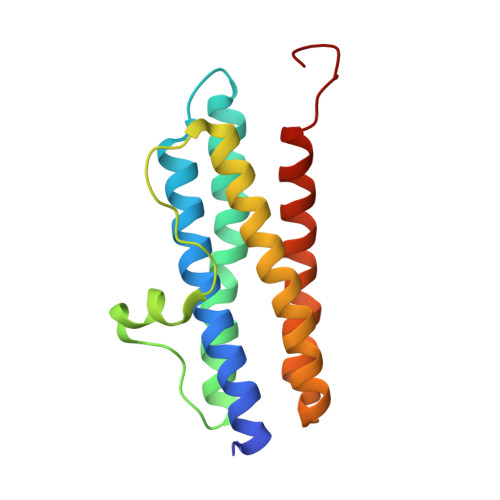Antioxidant Dps Protein from the Thermophilic Cyanobacterium Thermosynechococcus Elongatus.
Franceschini, S., Ceci, P., Alaleona, F., Chiancone, E., Ilari, A.(2006) FEBS J 273: 4913
- PubMed: 17018059
- DOI: https://doi.org/10.1111/j.1742-4658.2006.05490.x
- Primary Citation of Related Structures:
2C41 - PubMed Abstract:
DNA-binding proteins from starved cells (Dps proteins) protect bacteria primarily from oxidative damage. They are composed of 12 identical subunits assembled with 23-symmetry to form a compact cage-like structure known to be stable at temperatures > 70 degrees C and over a wide pH range. Thermosynechococcus elongatus Dps thermostability is increased dramatically relative to mesophilic Dps proteins. Hydrophobic interactions at the dimeric and trimeric interfaces called Dps-like are replaced by salt bridges and hydrogen bonds, a common strategy in thermophiles. Moreover, the buried surface area at the least-extended Dps-like interface is significantly increased. A peculiarity of T. elongatus Dps is the presence of a chloride ion coordinated with threefold symmetry-related arginine residues lining the opening of the Dps-like pore toward the internal cavity. T. elongatus Dps conserves the unusual intersubunit ferroxidase centre that allows the Dps protein family to oxidize Fe(II) with hydrogen peroxide, thereby inhibiting free radical production via Fenton chemistry. This catalytic property is of special importance in T. elongatus (which lacks the catalase gene) in the protection of DNA and photosystems I and II from hydrogen peroxide-mediated oxidative damage.
Organizational Affiliation:
C.N.R. Institute of Molecular Biology and Pathology, University of Rome La Sapienza, Piazzale E. Moro 5, 00185 Rome, Italy.

















